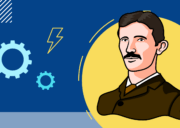
The story of Google is one of the most extraordinary tales in the modern technology world. From a modest university project to one of the most powerful and influential companies in the world, Google has made its mark on the evolution of the Internet and technology.
In this article, we will explore its history, from humble beginnings to the technologies and programming languages used, as well as the curiosities surrounding the company.
The Origins of Google
Towards the end of the 1990s, two doctoral students at Stanford University, Larry Page and Sergey Brin, developed a search engine called “Backrub.” Their goal was to improve the accuracy of search results on the Internet, thus revolutionizing online navigation.
The idea of creating a more efficient and accurate search engine emerged while Page and Brin were working on their academic studies in 1996. However, the company Google Inc. was officially established on September 4th, 1998, when Larry Page and Sergey Brin filed the necessary documents to register the domain google.com.
In fact, it was only in 1997, after receiving funding from an investor, that Backrub became Google. The name “Google” is a play on words based on “googol,” a mathematical term representing 1 followed by 100 zeros, emphasizing the vastness of the information that the search engine could catalog.
Their innovative technology for indexing and ranking web pages, based on the PageRank algorithm, allowed Google to provide significantly better search results than its competitors at the time. This algorithm not only considered the content of web pages but also the number and quality of links pointing to a specific page, assigning an “importance” score to web pages. This approach revolutionized internet search, quickly making Google the preferred search engine for users.
To build Google, Page and Brin primarily used the Java programming language, known for its portability and versatility. Java allowed them to develop a scalable and reliable system capable of handling large amounts of data.
Shortly after the formation of the company in 1999, Google moved to its current headquarters in Mountain View, California. This headquarters quickly became an icon in the tech world, known for its cutting-edge facilities and innovative atmosphere.

From the 2000s to Today: The Story of Google
In 2004, Google went public with an initial public offering (IPO), making the company accessible to the public and bringing in a significant amount of funding. This move accelerated the company’s growth and diversification into new sectors. During this period, Google continued to improve its search engine and introduced services like Gmail, Google Earth, and Google Maps. It also acquired YouTube in 2006, a strategic acquisition in the online video field.
In 2007, Google introduced its operating system for mobile devices, Android. This marked its entry into the smartphone market. Android quickly became the most widely used operating system in the world for mobile devices, powering smartphones and tablets from various companies.
Subsequently, in 2010, Google launched its web browser, Google Chrome, which became a significant competitor to Internet Explorer and Firefox. Chrome helped improve the browsing experience and popularized the concept of a “lightweight browser.”
Between 2010 and 2015, the company created Google X, a division dedicated to innovation and the development of futuristic projects. This division worked on ambitious projects such as autonomous vehicles and drones for delivery purposes. It also expanded into other fields by introducing Google Glass, smart glasses with augmented reality features. However, the product did not achieve the expected success, and the program was discontinued in 2015. In the same year, the company underwent a significant corporate restructuring, creating a holding company called Alphabet Inc., where Google became a subsidiary, allowing it to focus on its core activities such as search and advertising, while Alphabet explored more experimental projects in different sectors.
The company continued to grow and diversify while maintaining its primary mission of “organizing the world’s information and making it universally accessible and useful.” The story of Google is an example of how an initial academic idea can transform into one of the largest technology companies in the world.
Google’s Contribution to the Programming World
Google has also made contributions to the development of programming languages. The most well-known is Go (or Golang), an open-source programming language designed for creating scalable and reliable applications, among other things. Google developed Go to handle the growing needs of its systems.
Google has effectively made significant implementations in the programming world through the development and promotion of some key programming languages. The two most notable languages are Go (Golang) and Dart. Let’s see how they are used today:
Go (Golang): Go, often referred to as Golang, is an open-source programming language developed by Google. It was created to address some common challenges in software development, such as managing multicore systems and building scalable and reliable applications. Some distinctive features of Go include:
Simple and clear syntax: Go is designed to be readable and easy to write, making programming more efficient and reducing the potential for errors. Garbage collection: Go uses automatic garbage collection to simplify memory management, eliminating the risk of memory leaks. Concurrency: Go provides built-in support for concurrency through goroutines, making it easier to write parallelized applications. Today, Go is widely used for server-side application development, web services, cloud computing applications, and development tools. It has been adopted by many companies, including Google itself, Docker, Dropbox, and many others.
Dart: Dart is another programming language developed by Google. It was created with the goal of simplifying the development of modern web applications, particularly single-page web applications (SPAs) and mobile applications using the Flutter framework. Some features of Dart include:
JavaScript-like syntax: Dart has a syntax that may be familiar to JavaScript developers, making the transition to this language smoother. Just-in-Time (JIT) and Ahead-of-Time (AOT) compilation: Dart can be run using JIT for development and AOT for optimal performance in production.
Flutter: Dart is the primary language used for developing cross-platform applications using the Flutter framework. This framework has become increasingly popular for creating native mobile apps for both iOS and Android. Dart is primarily used for mobile and web application development, especially when using the Flutter framework. Due to its versatility, Dart is gaining popularity in frontend and mobile development.
Conclusion
The story of Google is an extraordinary example of how an original idea can transform into a powerful global force in technology. From its foundation to the present day, Google has profoundly influenced our daily lives and continues to innovate in various fields. Its journey is a testament to the power of innovation and ambition. Google will undoubtedly remain a company to watch as it continues to shape the future of technology.




